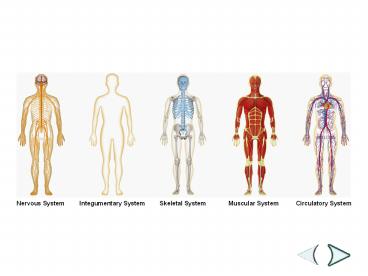Nervous System - PowerPoint PPT Presentation
1 / 15
Title:
Nervous System
Description:
Figure 35-2 Human Organ Systems Part I Section 35-1 Nervous System Integumentary System Skeletal System Muscular System Circulatory System Mouth Salivary glands ... – PowerPoint PPT presentation
Number of Views:93
Avg rating:3.0/5.0
Title: Nervous System
1
Figure 35-2 Human Organ Systems Part I
Section 35-1
Nervous System
Integumentary System
Skeletal System
Muscular System
Circulatory System
2
(No Transcript)
3
Figure 3810 The Digestive System
Section 38-2
4
Figure 3813 The Liver and the Pancreas
Section 38-2
5
Figure 37-11 The Lymphatic System
Section 37-2
Superior vena cava
Thymus
Heart
Thoracic duct
Spleen
Lymph nodes
Lymph vessels
6
The Urinary System
Section 38-3
Artery
Vein
Kidney (Cross Section)
Kidney
Cortex
Medulla
Ureter
Urinary bladder
Urethra
7
Figure 35-9 The Brain
Section 35-3
8
Figure 35-14 The Eye
Section 35-4
9
Figure 35-15 The Ear
Section 35-4
10
The Skeletal System
Section 36-1
Axial Skeleton
Appendicular Skeleton
11
Figure 36-13 The Structure of Skin
Section 36-3
12
Figure 37-13 The Respiratory System
Section 37-3
13
Figure 392 The Endocrine Glands
Section 39-1
Pineal gland The pineal gland releases melatonin,
which is involved in rhythmic activities, such as
daily sleep-wake cycles.
Hypothalamus The hypothalamus makes hormones that
control the pituitary gland. In addition, it
makes hormones that are stored in the pituitary
gland.
Thyroid The thyroid produces thyroxine, which
regulates metabolism.
Pituitary gland The pituitary gland produces
hormones that regulate many of the other
endocrine glands.
Pancreas The pancreas produces insulin and
glucagon, which regulate the level of glucose in
the blood.
Parathyroid glands These four glands release
parathyroid hormone, which regulate the level of
calcium in the blood.
Ovary The ovaries produce estrogen and
progesterone. Estrogen is required for the
development of secondary sex characteristics and
for the development of eggs. Progesterone
prepares the uterus for a fertilized egg.
Thymus During childhood, the thymus releases
thymosin, which stimulates Tcell development.
Testis The testes produce testosterone, which is
responsible for sperm production and the
development of male secondary sex characteristics
Adrenal glands The adrenal glands release
epinephrine and nonepinephrine, which help the
body deal with stress.
14
Figure 3912 The Male Reproductive System
Section 39-3
15
Figure 3914 The Female Reproductive System
Section 39-3































